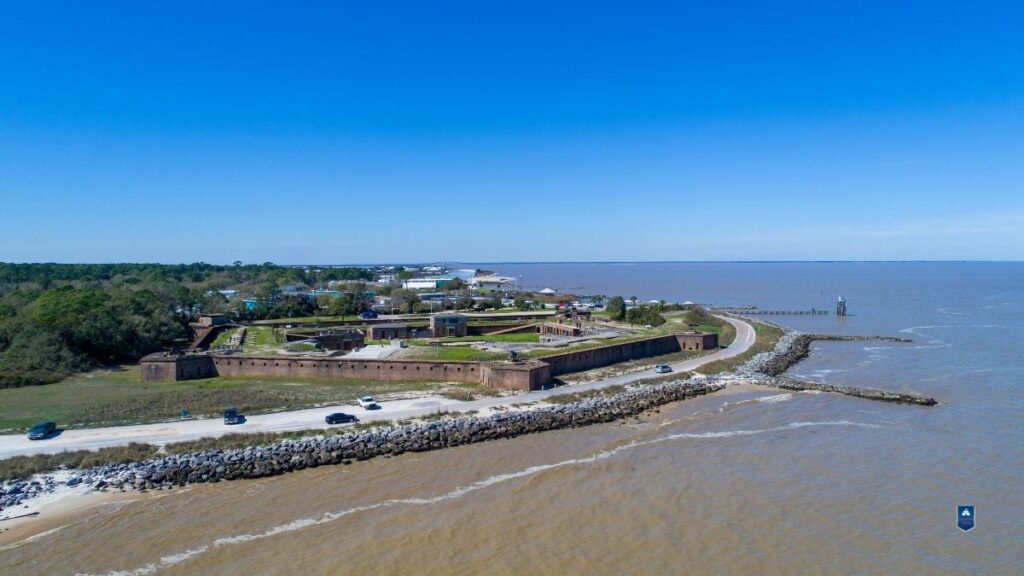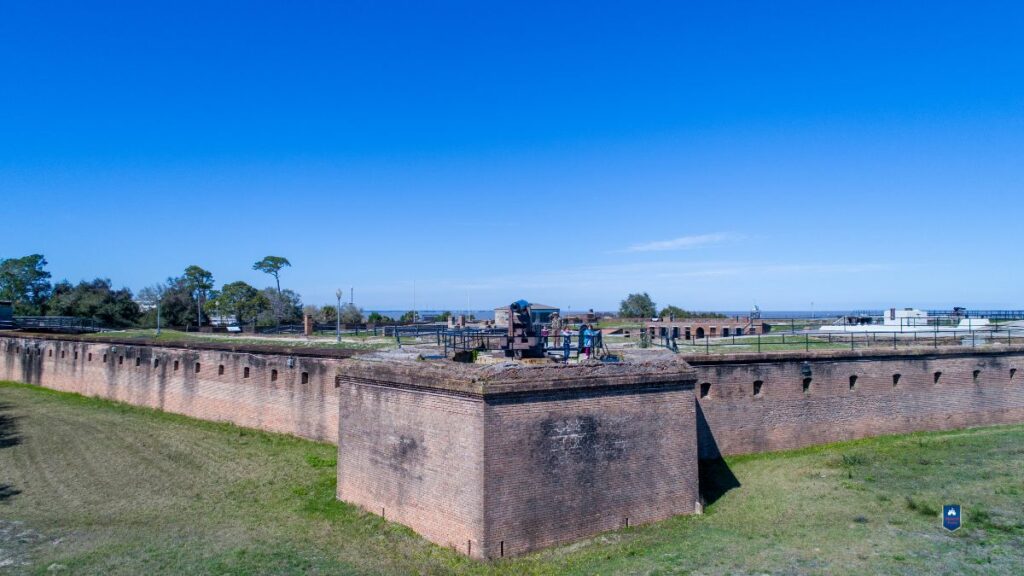Fort Gaines, perched on Dauphin Island’s eastern tip in Alabama, offers a fascinating glimpse into America’s coastal defense history.
Established in 1821 to protect Mobile Bay, this fort is named after General Edmund Pendleton Gaines.
It played a crucial role in the Civil War, especially during the Battle of Mobile Bay, where Admiral Farragut famously commanded, “Damn the torpedoes, full speed ahead!”
Beyond its military significance, Fort Gaines boasts a rich tapestry of history, including Native American artifacts and connections to French explorers.
Today, it is a well-preserved monument, attracting visitors with its historical reenactments and scenic views.
Historic Fort Gaines

Historic Fort Gaines sits on the eastern tip of Dauphin Island, Alabama. Established in 1821, its primary function was to guard the entrance to Mobile Bay. The fort was named after General Edmund Pendleton Gaines, a key military figure.
Fort Gaines was pivotal in the Battle of Mobile Bay during the American Civil War. Union Admiral David G. Farragut famously issued his order, “Damn the torpedoes, full speed ahead!” from his flagship here.
Traces of Native American presence can be found, with artifacts suggesting the area’s long history. In the late 17th century, French explorers named the island “Massacre Island” due to the large number of human bones on its shores.
Fort Gaines also saw activity in the Spanish-American War and World War II. It has well-preserved structures and cannons from over a century ago.
The fort is now known for historical reenactment events, drawing many visitors yearly. It was listed as one of the “Eleven Most Endangered Historic Sites” due to coastal erosion issues.
Visitors can explore the original guardhouse, barracks, and tunnels. Information on various historical periods focuses on the fort’s strategic importance. Recreational and educational activities help preserve the site’s rich heritage.
Geographical Location

Historic Fort Gaines is situated at the eastern tip of Dauphin Island in Alabama.
Dauphin Island lies along the Gulf Coast, bordered by the Gulf of Mexico to the south and Mobile Bay to the north. The fort provides picturesque views of the surrounding waters.
Nearby locations:
- Dauphin Island Park: A notable park offering recreational activities.
- Gulf Shores and Orange Beach: Popular tourist destinations located further east.
The island’s north shore offers a variety of ecosystems, including marshes and dunes. This unique geographic positioning has strategic historical significance, especially for naval defense.
The nearby Gulf of Mexico has also shaped the island’s climatic and ecological characteristics.
Coordinates: The fort is located at approximately 30°15’N latitude and 88°04’W longitude.
Key Features
- Eastern Tip of Dauphin Island: Location of Fort Gaines.
- Gulf Coast: Defines the southern boundary.
- Mobile Bay: To the north of the island.
- Proximity to Gulf Shores and Orange Beach: Enhances its accessibility.
These geographical features make Fort Gaines a historical site and a scenic destination for visitors.
Architecture and Design

Fort Gaines exhibits a distinctive architectural style from the pre-Civil War era. Its well-preserved ramparts stand as solid defenses, showcasing expert masonry and engineering practices of the time.
The fort’s corner bastions are notable for their strategic gun placements. These bastions provided robust defensive capabilities, allowing artillery coverage from multiple angles.
Its exterior walls, constructed from sturdy bricks, have withstood the test of time. Their thickness and height underscore their defensive purpose.
Inside, the fort houses pre-Civil War brick buildings. These structures served various purposes, including living quarters and storage spaces, exemplifying practical design.
The northwest bastion is imposing, with its original cannons still in place. This feature offers a glimpse into the fort’s historical firepower.
Visitors can also explore tunnel systems connecting different sections of the fort. These passages allowed soldiers to move safely and covertly during conflicts.
Spiral stone staircases lead to key observation points and offer architectural charm. Their design ensures quick access between different levels of the fort.
The inner courtyard is the fort’s central area, providing open space for drills and daily activities. Its layout reflects the military discipline and organization of the period.
Visiting Fort Gaines
Visitors to Fort Gaines can enjoy a variety of attractions and activities. Group tours offer insights into the fort’s history and features. These tours often include stops at the operational blacksmith shop and the working forge.
A visit is not complete without seeing the enormous anchor of the USS Hartford. Various historical artifacts are also on display, providing a tangible connection to the past.
The gift shop is an excellent place to purchase souvenirs, including period uniforms. These make for unique souvenirs or gifts.
Visitors will also appreciate the panoramic views of the bay, which offer great photo opportunities and a peaceful setting for reflection.
Fort Gaines does not operate on Christmas Eve, Christmas Day, and Thanksgiving Day. To ensure availability and a seamless experience, advanced notice is recommended for those planning group tours.
Nearby, the beach board offers great places to relax. Consider visiting the resort area for some of the best condos and a variety of dining options.
Military Importance

Fort Gaines held significant military value during its operational years. Positioned on Dauphin Island, it played a key role in protecting the entrance to Mobile Bay.
Role of Fort Gaines
The fort provided a strategic point for harbor defense against naval invasions. Its location allowed control over maritime traffic entering Mobile Bay, a crucial industrial and shipping hub.
Union Soldiers and Federal Troops
During the Civil War, Union soldiers and federal troops utilized Fort Gaines to monitor and control Confederate supply lines. Their control over the fort significantly impacted the Confederate states’ ability to receive supplies.
Alabama State Militia
Initially, Fort Gaines was manned by the Alabama State Militia. These local forces were responsible for the fort’s early defenses before it fell into Union hands.
Harbor Defense Plans
Joseph G. Totten, a prominent engineer, contributed to the fort’s design, emphasizing its defensive capabilities. His plans included multiple gun emplacements to cover every approach by sea.
Connection with Fort Morgan and Fort Bowyer
Fort Gaines worked with neighboring Fort Morgan and Fort Bowyer to create a network of coastal defenses. This triad ensured a robust defensive line protecting key Confederate territories.
Historical Figures
Among the notable figures associated with Fort Gaines was a member of French royalty who contributed to its architectural design. Such involvement highlights the international interest in the fort’s strategic importance.
Cultural and Educational Activities
Historic Fort Gaines offers a variety of cultural and educational activities. These events and programs cater to diverse interests and make history come alive for visitors of all ages.
Historical Reenactment Events: Fort Gaines hosts reenactments that showcase pivotal moments in its history. These events feature actors in period costumes, giving a vivid glimpse into the past.
U.S. Coast Guard Involvement: The fort has ties with the U.S. Coast Guard, which set up an Anti-Aircraft Gunnery School here, providing historical insights into military training and coastal defense strategies.
Fort Gaines also highlights its connections with the Alabama National Guard. Displays and presentations offer detailed information about the Guard’s activities and contributions.
Visitors can learn about members of French royalty who once walked the grounds of Fort Gaines. This aspect adds a unique European link to the fort’s diverse history.
City of Mobile: Collaborative programs with the City of Mobile bring educational resources and local history into the fort’s activities, enriching the experience with regional heritage.
Engagements led by Melinda Oalmann provide deeper educational content. Her expertise in historical research ensures that the narratives shared are accurate and informative.
Fort Gaines’s educational programs utilize a range of formats, including interactive exhibits, guided tours, lectures, and hands-on workshops. These activities are designed to be engaging and educational, appealing to casual visitors and serious history enthusiasts.
Special events often feature presentations by historians and experts who discuss various aspects of military and local history. These sessions are valuable for anyone wanting to gain in-depth knowledge.
Environmental Challenges
Historic Fort Gaines faces significant environmental challenges that threaten its preservation and integrity. One of the most pressing issues is ongoing shoreline erosion.
Constant encroachment of the Gulf of Mexico has caused substantial damage to the fort’s structure and surrounding areas. Erosion reduces the landmass, making maintaining and protecting the historic site difficult.
Non-profit organizations are actively involved in efforts to combat these issues. They collaborate with local authorities to implement solutions such as building breakwaters and installing vegetation to stabilize the soil. These organizations are crucial in raising funds and awareness for the preservation of the fort.
The Alabama Department of Conservation is pivotal in addressing environmental challenges at Historic Fort Gaines.
They conduct regular assessments to monitor erosion rates and the ecosystem’s health. The department also oversees the implementation of conservation projects designed to protect and sustain the fort’s environment.
Shell Mound Park, located nearby, also faces similar erosion problems. Efforts to preserve this park’s native shell mounds can provide insights and techniques that might be applied to protecting Fort Gaines.
The shared challenges foster collaborations that aim to safeguard both sites.
Local communities are engaged in these conservation efforts, recognizing Fort Gaines’s historic and cultural value.
Events and activities are often organized to educate the public about the fort’s history and the need for environmental preservation. These activities help foster a sense of community and drive collective action toward conservation.
Explore More: Army Forts in Alabama
Rich Heritage of Fort Gaines
Fort Gaines, located in Clay County, has a rich history that fascinates many. Established as part of the new territory of Alabama, the fort became a critical defense post for the United States.
Originally designed to protect settlers in the Southwest Georgia region, the fort presents a unique glimpse into early American frontier life.
Key Historical Figures:
- French Explorer who first charted the region.
- Member of French Royalty associated with early exploration.
Fort Gaines played pivotal roles during various conflicts, including the Spanish-American War. Its strategic location offered significant military advantages.
Importance of Key Sites:
- Original barracks
- Historic cannons
- Defensive walls
These sites retain the fort’s legacy, attracting those keen on American history. Fort Gaines’ enduring structures and storied past continue to educate and inspire many visitors yearly.
Explore More: 19 Historic Forts in Alabama
Preservation Efforts
Fort Gaines has benefitted from various preservation efforts to maintain its historical significance.
The National Trust for Historic Preservation listed it as one of the Eleven Most Endangered Historic Sites, garnering attention and support from preservationists.
Non-profit organizations play a crucial role in these efforts.
They help ensure the fort’s longevity by raising funds and awareness. Grants and donations facilitate structural repairs, archaeological research, and educational programs.
Managed as a State Park, Fort Gaines enjoys the protection and resources that come with this designation.
This status ensures ongoing maintenance and public access, allowing visitors to appreciate the site while contributing to its upkeep.
The coordination between state authorities and local groups underscores the importance of community involvement.
Regular events, tours, and volunteer activities help foster a sense of ownership and pride among residents and visitors alike.
These combined efforts reflect a commitment to preserving Fort Gaines for future generations.
Through diligent work and community support, the fort remains a vibrant link to the past.

Cory is a website owner and content creator who enjoys fishing, history, coin collecting, and sports, among other hobbies. He is a husband and father of four.
Romans 15:4 For whatever was written in former days was written for our instruction, that through endurance and through the encouragement of the Scriptures we might have hope.

